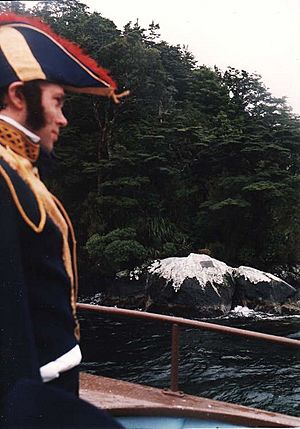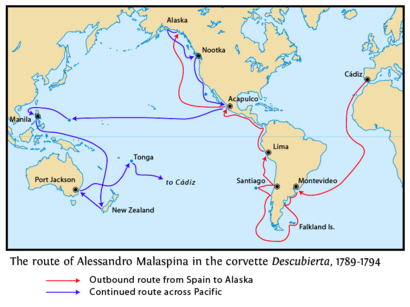Alejandro Malaspina facts for kids
Quick facts for kids
Alejandro Malaspina
|
|
|---|---|
 |
|
| Birth name | Alessandro Malaspina |
| Born | November 5, 1754 Mulazzo, Grand Duchy of Tuscany, Holy Roman Empire |
| Died | April 9, 1810 (aged 55) Pontremoli, French Empire |
| Allegiance | |
| Service/ |
|
| Years of service | 1774–1795 |
| Rank | Brigadier |
| Commands held | Malaspina Expedition |
| Battles/wars | Great Siege of Gibraltar |
Alejandro Malaspina (born November 5, 1754 – died April 9, 1810) was an Italian explorer who spent most of his life as a Spanish naval officer. He is famous for leading a big scientific journey around the world. From 1789 to 1794, his expedition explored and mapped much of the west coast of the Americas, from Cape Horn all the way to Alaska. They also visited places like Guam, the Philippines, New Zealand, Australia, and Tonga.
Malaspina was born "Alessandro" but signed his letters in Spanish as "Alexandro." Today, people usually call him "Alejandro."
Contents
Early Life
Alessandro Malaspina was born in Mulazzo, a small area ruled by his family. This place was part of the Grand Duchy of Tuscany at the time. His parents were Marquis Carlo Morello and Caterina Meli Lupi di Soragna.
From 1762 to 1765, his family lived in Palermo, where his great-uncle was the ruler of Sicily. Alessandro studied in Rome from 1765 to 1773. In 1773, he joined the Order of Malta. He spent about a year on the island of Malta, learning how to sail.
In 1774, Malaspina joined the Royal Navy of Spain as a Guardiamarina, which is like a midshipman.
He took part in many naval battles and quickly moved up in rank. In 1775, he helped in the fight to protect Melilla from Moroccan forces. He was promoted to frigate-ensign shortly after. He also took part in the siege of Algiers in 1775.
From 1777 to 1779, Malaspina sailed to the Philippines and back, going around the Cape of Good Hope. He was promoted to frigate-lieutenant during this trip. In 1780, he fought in the Battle of Cape Santa Maria. He was promoted again to ship's lieutenant. During the Great Siege of Gibraltar in 1782, he served on a "floating battery." Later that year, he fought in the fighting at Cape Espartel and became a frigate-captain.
From 1783 to 1784, Malaspina was second-in-command on another trip to the Philippines. In 1785, he helped map parts of the Spanish coast.
Around the World Voyage

From 1786 to 1788, Malaspina sailed around the world for a trading company. He was in charge of the frigate Astrea. His journey took him around Cape Horn and back around the Cape of Good Hope.
In 1787, his ship stopped in Concepción, Chile. The governor there, Ambrosio O'Higgins, had suggested that Spain should send an expedition to the Pacific, similar to those led by famous explorers like Lapérouse and James Cook. Malaspina liked this idea. After he returned to Spain, he and his partner, José de Bustamante, suggested their own plan for a big expedition. The Spanish government quickly agreed. They were especially interested because they heard Russia was planning an expedition to the North Pacific, which might claim land Spain also wanted.
The Great Expedition (1789–1794)
In September 1788, Alessandro Malaspina and José de Bustamante y Guerra proposed a scientific journey to the Spanish government. They wanted to visit almost all Spanish lands in America and Asia. The Spanish king, Charles III, who supported science, approved their plan.
Planning the Journey
Two special ships were built for the expedition: Descubierta (meaning "Discovery") and Atrevida (meaning "Daring"). Malaspina commanded Descubierta, and Bustamante commanded Atrevida. Malaspina chose these names to honor James Cook's ships, Discovery and Resolution. Both ships were launched on April 8, 1789.
The expedition was led by both Malaspina and Bustamante. Even though it became known as Malaspina's expedition, Bustamante was always an equal leader.
Exploring the Americas
The expedition left Cádiz, Spain, on July 30, 1789. They first sailed to Montevideo and Buenos Aires in South America. They studied the political situation in these areas. After sailing around Cape Horn, they stopped in Talcahuano and Valparaíso in Chile.
They continued north, with Bustamante mapping the coast. Malaspina sailed to the Juan Fernández Islands to check their exact location. The two captains met again in Callao, Peru, and then continued mapping the coast north to Acapulco, Mexico. A team of officers went to Mexico City to study the local history and government.
Search for the Northwest Passage
In Mexico in 1791, Malaspina received new orders from the king. He was told to search for a Northwest Passage around 60 degrees North latitude. This was a rumored sea route through North America. Malaspina had planned to go to Hawaii and Kamchatka, but instead, he sailed directly to Yakutat Bay, Alaska.
He found only an inlet, not a passage. He then carefully mapped the Alaskan coast west to Prince William Sound. At Yakutat Bay, the expedition met the Tlingit people. Spanish scientists studied their culture, language, and way of life. Artists drew portraits of the Tlingit people. A large glacier in Alaska was later named after Malaspina.
Visiting Nootka Sound
Malaspina knew that Captain Cook had already explored the coast west of Prince William Sound and found no passage. So, he stopped his search and sailed to the Spanish outpost at Nootka Sound on Vancouver Island.
The expedition stayed at Nootka Sound for two weeks. Scientists studied the Nuu-chah-nulth people. When Malaspina arrived, the relationship between the Spanish and the Nootkas was not good. Malaspina and his crew worked hard to improve it, which was one of their main goals. By giving generous gifts, they built trust with the Nootka chief, Maquinna. This was important because Maquinna was a powerful chief. His friendship helped Spain's claim to Nootka Sound, which was being discussed with Britain.
The expedition also made detailed maps of Nootka Sound. They explored unknown channels and linked their maps to those made by Captain Cook. They also studied plants and tried to make a type of beer from spruce needles to fight scurvy, a disease caused by lack of Vitamin C.
After Nootka Sound, the ships sailed south to Monterey, California, before returning to Mexico. In 1792, Malaspina sent two smaller ships, Sutíl and Mexicana, to explore the Strait of Juan de Fuca and the Strait of Georgia in more detail.
Across the Pacific
In 1792, Malaspina's expedition sailed across the Pacific Ocean from Mexico. They stopped briefly at Guam before spending several months in the Philippines, mainly in Manila. During this time, Bustamante sailed the Atrevida to Macau, China.
After Bustamante returned, the expedition left the Philippines and sailed to New Zealand. They explored Doubtful Sound on New Zealand's South Island, mapping it and doing scientific tests. Then, Malaspina sailed to Port Jackson (Sydney) in New South Wales, Australia. This was a British settlement founded in 1788.
The expedition's visit to Sydney was important. They made twelve drawings that show what the settlement looked like in its early years. One of Malaspina's officers warned that this British colony could be a threat to Spanish lands in the Pacific during wartime.
Returning east across the Pacific, the expedition spent a month at Vava'u, an island group in Tonga. From there, they sailed back to Callao, Peru, then Talcahuanco, Chile. They carefully mapped the fjords of southern Chile before going around Cape Horn. They also surveyed the Falkland Islands and the coast of Patagonia. Their last stop was Montevideo.
Malaspina then took a long route across the Atlantic Ocean back to Spain, arriving in Cádiz on September 21, 1794. He had spent 62 months at sea.
Discoveries and Achievements
During this five-year journey, Malaspina mapped the western coast of America with amazing accuracy. He measured the height of Mount Saint Elias in Alaska and explored huge glaciers, like the Malaspina Glacier, which was later named after him. He also showed that a Panama Canal could be built and made plans for it.
His expedition was one of the first long sea voyages with almost no cases of scurvy. Malaspina's doctor, Pedro González, believed that fresh oranges and lemons were key to preventing scurvy. Only a few sailors got sick on one long trip, but they recovered quickly after getting fresh fruit in Guam. This was a big step in keeping sailors healthy on long journeys.
Later Years
After his great journey, Malaspina faced some difficulties and was imprisoned in Spain. Later, he returned to Italy. He became involved in local politics in Pontremoli. He died in Pontremoli on April 9, 1810, at the age of 55.
Legacy
Many places are named after Alejandro Malaspina.
- Malaspina University-College (now Vancouver Island University) and Malaspina International High School in Nanaimo, British Columbia, Canada, were named after him.
- There is also Malaspina Strait, Malaspina Peninsula, and Malaspina Provincial Park in British Columbia.
- Vancouver Island University has the Alexandro Malaspina Research Centre.
- There is a Malaspina Peak and Malaspina Lake near Nootka Sound on Vancouver Island.
- The well-known Malaspina Glacier is in southern Alaska.
- In New Zealand, Malaspina Reach of Doubtful Sound in Fiordland is named after him.
See Also
 In Spanish: Alejandro Malaspina para niños
In Spanish: Alejandro Malaspina para niños
- European and American voyages of scientific exploration
- José de Moraleda y Montero, Spanish Navy explorer contemporary with Malaspina


